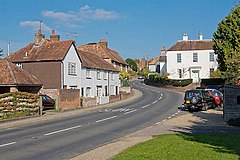Droxford
| Droxford | |
|---|---|
 High Street, Droxford | |
| Population | 600 [1] |
| OS grid reference | SU 60738 18662 |
| District | |
| Shire county | |
| Region | |
| Country | England |
| Sovereign state | United Kingdom |
| Post town | SOUTHAMPTON |
| Postcode district | SO32 |
| Dialling code | 01489 |
| Police | Hampshire and Isle of Wight |
| Fire | Hampshire and Isle of Wight |
| Ambulance | South Central |
| UK Parliament | |
Droxford is a village in Hampshire, England, lying in the Meon valley, and lies around 3+3⁄4 miles (6.0 km) east of Bishop's Waltham within the new South Downs National Park. The A32 passes through the village between Gosport and Alton. Local amenities include a post office, two garages, two pubs and a village hall.
Droxford is first recorded in history when the Manor of Drocenesforda (Droxford) was granted to the Prior and monks of St. Swithun, Winchester, by King Egbert in 826. In 939 king Æthelstan granted 17 hides of land at Droxford to his half-sister Eadburh.[2] By the time of the Domesday Survey Droxford had passed to the Bishop of Winchester, to support the monks. This arrangement continued until 1551 when it was surrendered to the crown and it was passed on to the Earl of Wiltshire.
The Bishopric regained the manor in 1558 and then held it until the Civil War. During the rule of Parliament the manor was transferred into private hands but on the Restoration of King Charles II it was, again, restored to the Bishopric.
This situation then continued until 1869, when the manor was finally removed from the Bishopric as part of the Bishops' Resignation Act of 1869.
The railway came to Droxford in 1903 with the building of the Meon Valley Railway. A station was built around 1⁄2 mile (0.80 km) outside the village on the other side of the river. A small sub-settlement grew around the station including a hotel, railway workers' cottages and a cluster of private homes.
In June 1944 Allied leaders including, Churchill, Eisenhower and de Gaulle met in a train carriage at Droxford station to discuss the imminent D-Day invasion. There is a bench in the village to commemorate this meeting of world leaders in Droxford. British Railways closed the railway in 1962.
References
External links

